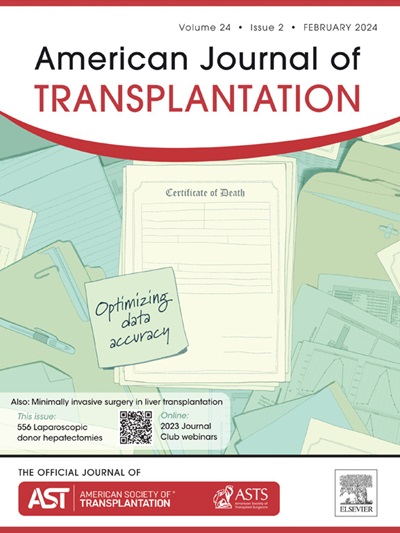OPTN/SRTR 2023 Annual Data Report: Lung
IF 8.9
2区 医学
Q1 SURGERY
引用次数: 0
Abstract
The year 2023 marked a year of major transition for the lung transplant community in the United States, as it became the first to adopt the continuous distribution system for organ allocation. Starting on March 9, 2023, the composite allocation score (CAS) was used to rank candidates for access to a lung transplant. Shortly after the adoption of this CAS system, it was amended to better represent the biological disadvantage of candidates with blood type O for accessing a donor organ. Despite the challenges of implementing major changes to the system, the year 2023 marked many successes and milestones in US lung transplantation. A total of 3,049 adult lung transplants were performed, representing the most transplants performed in any single year. Transplant rates continued their increase over time and reached an all-time high of 307.6 transplants per 100 patient-years for adults on the waiting list. By 1 year after listing, 81.2% of adult candidates underwent a deceased donor lung transplant, with 62.6% of them having waited 3 months or less. Adult waitlist mortality rates decreased to their lowest at 13.3 deaths per 100 patient-years, meeting one of the major goals of the organ allocation systems: to decrease waitlist mortality. Survival after lung transplant remained stable over the past decade with 88.5% of adults who underwent transplant in 2022 surviving to 1 year compared with 87.2% of adults who underwent transplant in 2013.

求助全文
约1分钟内获得全文
求助全文
来源期刊
CiteScore
18.70
自引率
4.50%
发文量
346
审稿时长
26 days
期刊介绍:
The American Journal of Transplantation is a leading journal in the field of transplantation. It serves as a forum for debate and reassessment, an agent of change, and a major platform for promoting understanding, improving results, and advancing science. Published monthly, it provides an essential resource for researchers and clinicians worldwide.
The journal publishes original articles, case reports, invited reviews, letters to the editor, critical reviews, news features, consensus documents, and guidelines over 12 issues a year. It covers all major subject areas in transplantation, including thoracic (heart, lung), abdominal (kidney, liver, pancreas, islets), tissue and stem cell transplantation, organ and tissue donation and preservation, tissue injury, repair, inflammation, and aging, histocompatibility, drugs and pharmacology, graft survival, and prevention of graft dysfunction and failure. It also explores ethical and social issues in the field.

 求助内容:
求助内容: 应助结果提醒方式:
应助结果提醒方式:


